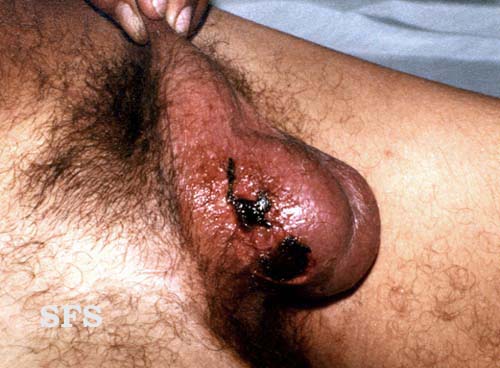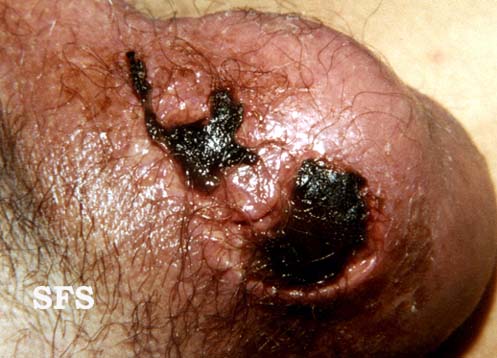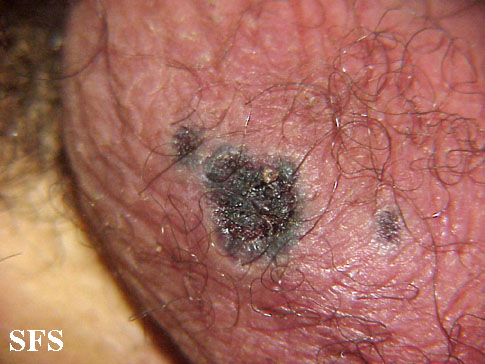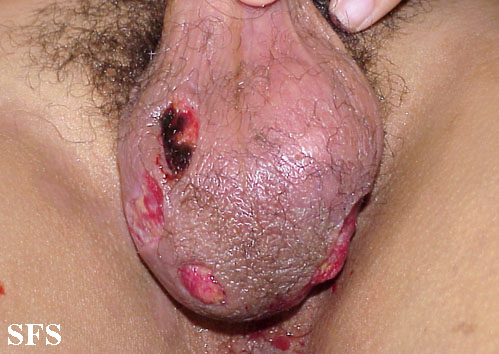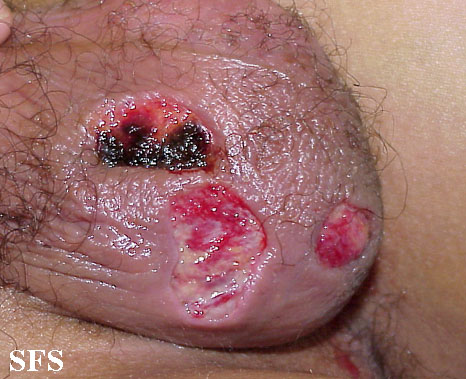Fournier gangrene
| Fournier gangrene | |
| ICD-10 | N49.8 (ILDS N49.81), N76.8 |
|---|---|
| ICD-9 | 608.83 |
| DiseasesDB | 31119 |
| MeSH | D018934 |
Template:Search infobox Steven C. Campbell, M.D., Ph.D. Associate Editor(s)-in-Chief: Jesus Rosario Hernandez, M.D. [1].
Overview
Fournier gangrene is a type of necrotizing infection (gangrene) usually affecting the male genitals. It is a type of necrotizing fasciitis.
It was first described by Baurienne in 1764 and is named after a French venereologist, Jean-Alfred Fournier following five cases he presented in clinical lectures in 1883.
Aetiology
In the majority of cases Fournier gangrene is a mixed infection caused by both aerobic and anaerobic bacteria.[1]
Incidence
Only 600 cases of Fournier gangrene were reported in the world literature in the ten years since 1996, with most patients in their 60s or 70s with other concurrent illnesses.[2] However, Fournier's gangrene is not a reportable illness, and the condition is not uncommon, especially among diabetic individuals. A similar infection in women has been occasionally described.[3]
In Turkey it was reported that 46% of patients had diabetes mellitus[4] whilst other studies have identified approximately a third of patients having either diabetes, alcoholism or malnutrition, and 10% having medical immunosuppression (chemotherapy, steroids, malignancy).[5]
Physical examination
Gallery
Genitourinary system
Treatment
Fournier gangrene is a urological emergency requiring intravenous antibiotics and debridement (surgical removal) of necrotic (dead) tissue. Despite such measures, the mortality rate overall is 40%, but 78% if sepsis is already present at the time of initial hospital admission.[4]
Antimicrobial Therapy
- Fournier gangrene[6]
- If caused by streptococcus species or clostridia
- Preferred regimen: Penicillin G
- Polymicrobial
-
- MRSA (methicillin resistant staphylococcus aureus) suspected
- Preferred regimen: vancomycin OR daptomycin
Footnotes
- ↑ Thwaini A, Khan A, Malik A, Cherian J, Barua J, Shergill I, Mammen K (2006). "Fournier's gangrene and its emergency management". Postgrad Med J. 82 (970): 516–9. PMID 16891442.
- ↑ Vaz I (2006). "Fournier gangrene". Trop Doct. 36 (4): 203–4. PMID 17034687.
- ↑ Herzog W (1987). "[Fournier gangrene--also in females?]". Zentralbl Chir. 112 (9): 564–76. PMID 2956804.
- ↑ 4.0 4.1 Yanar H, Taviloglu K, Ertekin C, Guloglu R, Zorba U, Cabioglu N, Baspinar I (2006). "Fournier's gangrene: risk factors and strategies for management". World J Surg. 30 (9): 1750–4. PMID 16927060.
- ↑ Tahmaz L, Erdemir F, Kibar Y, Cosar A, Yalcýn O (2006). "Fournier's gangrene: report of thirty-three cases and a review of the literature". Int J Urol. 13 (7): 960–7. PMID 16882063.
- ↑ Gilbert, David (2015). The Sanford guide to antimicrobial therapy. Sperryville, Va: Antimicrobial Therapy. ISBN 978-1930808843.
External links
